 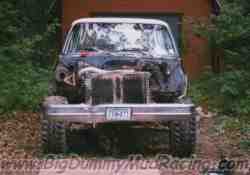 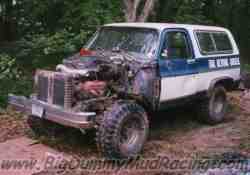 |
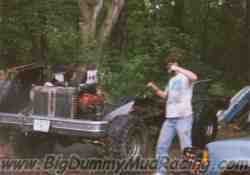 |
Once the body was off, it was back to cleaning. We spent another hour and a half with the pressure washer and STILL didn't get it completely clean! |  |
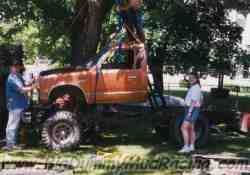 |
We then rolled the Blazer frame underneath the body, and carefully lowered the body onto the frame. Here you can see the spotters hard at work. | 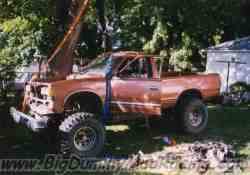 |
| With the arrival of the spring of '97, we set our sites on finishing the truck for Memorial Day. Aside from tying up some of the loose ends, we started focusing on the drivetrain. We knew that the old 1/2 ton equipment just wouldn't hold up to the torture of 44's, and a good motor. During the winter I had picked up a '70 3/4 ton with a NP205 transfer case, and an Eaton ho72 rear. These parts were combined with a Dana 60 front end and a 4.56:1 3rd member for the rear (to match the gears with the front). We would have gone with higher gears, but 4.56 is the highest that was ever made for the ho72. |
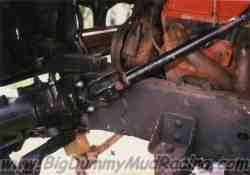 |
Just to show that we are for the most part non denominational, this lower u-joint in the steering system was borrowed from a '72 International Scout. |
| Here are the "brains" of the operation. We run an MSD-6A ignition (the same one used in Winston Cup cars), with a high output coil. | 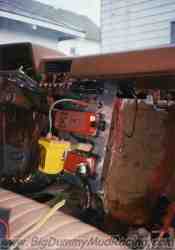 |
| Amidst the majority of the last minute drive train work, the bodywork was being finished. After touching up some cosmetic blemishes, the truck was ready to be one color... Black, of course! |
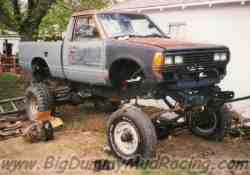 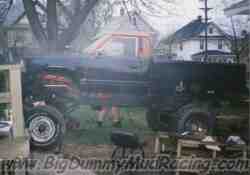 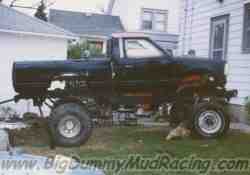 |
| Though I don't have any pictures of it, the cooling system (almost completely Jason's handiwork) deserves mention. We placed the radiator in the back of the truck so that it would stay clean. Between the radiator and the water pump, we run 1-1/2 inch copper pipe with soldered fittings to work around the frame and other obstructions, which are connected to the frame using rubber exhaust hangers. We connect at each end with a short section of rubber hose for flexibility. The system as a whole works flawlessly, runs cooler than most street trucks, and holds up to the all the abuse we can dish out. |
| Motor: | '68 Corvette 350, Edelbrock Victor intake, 298H Comp cam, |
| Frame: | '77 Chevy Blazer |
| Body: | '86 Datsun pickup, approximately 8 inch custom body lift (to fit the motor under the hood) |
| Drivetrain: | 12 inch suspension lift, TH350 transmission w/ 3000 rpm TCI stall, NP205 transfer case, Dana 60 front axle (full time hubs) w/ Dana PowerLock, Eaton ho72 rear axle w/ welded posi, 4.56:1 axle ratios, Heavy duty driveshafts w/cv joints @ t-case end. |
| Wheels: | 44/19 x 16.5 TSL Swamper Boggers on Bart rims |
Click here to check out Highlander's first time out!